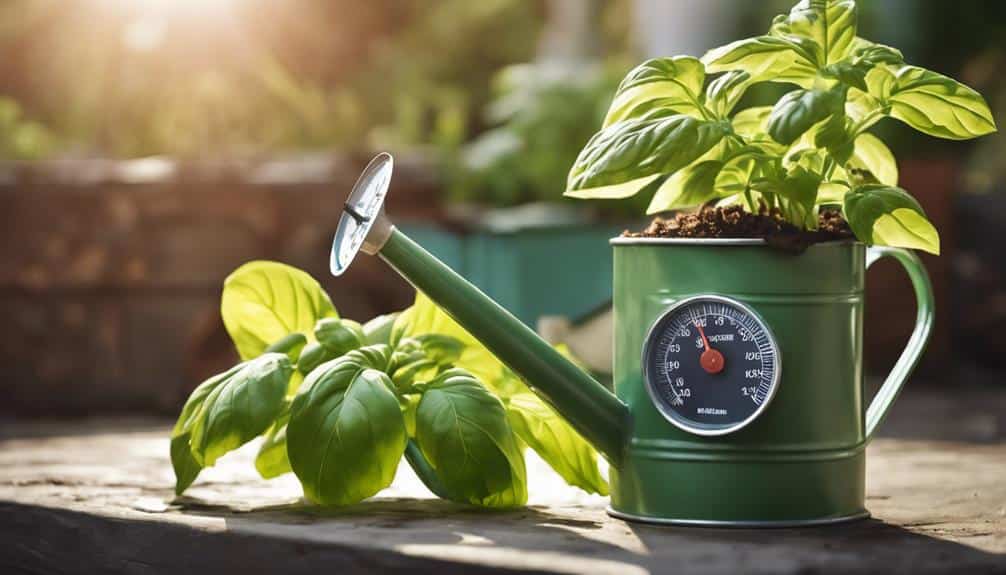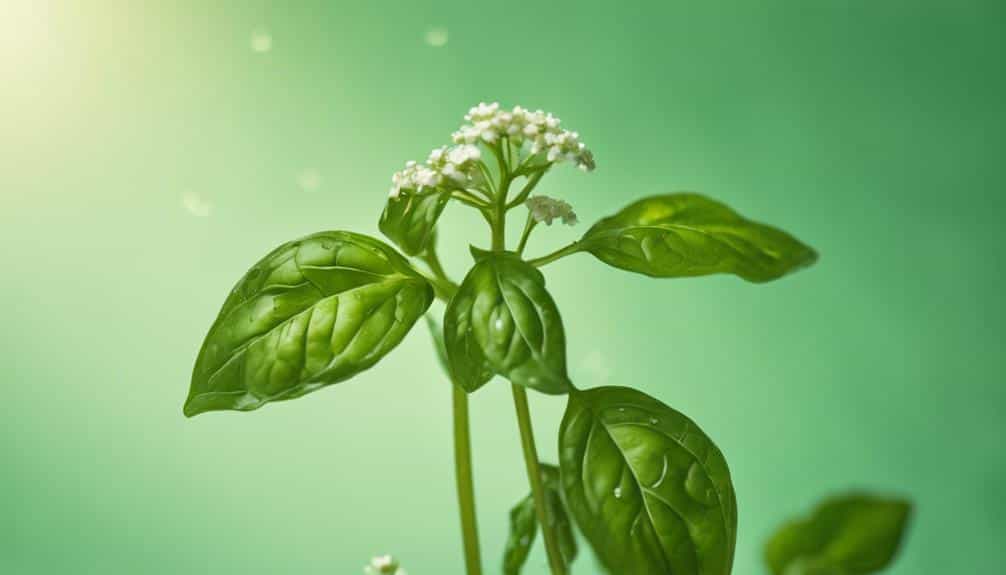Why Is My Basil Turning Yellow
Your basil is turning yellow, and you're unsure why. It could be because of too much water, not enough nutrients in the soil, bad lighting or temperature, poor air circulation, or bugs and diseases.
If you water too often, the roots may rot, making the leaves turn yellow. If the soil lacks important nutrients, the leaves can also turn yellow.
Once you figure out the problem, you can fix it and help your basil turn green again. Learn how to find the issue and make things right for your basil to thrive.
TLDR
- Yellow leaves on basil can happen because of root rot, diseases, bugs, too much water, lack of nutrients, not enough light, or poor air flow.
- Look for bugs like aphids, whiteflies, or spider mites, or diseases like downy mildew or fusarium wilt.
- Too much watering can cause root rot, so make sure the soil is damp but not soaked.
- Not enough nutrients can make the leaves yellow, so use the right fertilizer.
- Bad air flow and not enough light can also make the leaves turn yellow, so keep the air moving and give the plant enough light.
Common Causes of Yellowing

If your basil leaves are turning yellow, it's a sign that something's wrong, and you need to figure out why to save your plant.
One common reason is root rot, a fungal disease that likes wet conditions and can kill your basil. Diseases like downy mildew and fusarium wilt can also make basil leaves yellow. Bugs like aphids, whiteflies, and spider mites can play a part too.
Finding out the cause is crucial to fixing the problem and stopping more damage. Knowing why basil leaves turn yellow helps you take the right steps to help your plant recover.
Overwatering and Root Rot
You might be watering your basil plant too much, which could be causing its leaves to turn yellow. When you give it too much water, the roots can start to rot because the soil becomes too wet. This makes it easy for harmful germs to grow and damage the roots.
As a result, the roots struggle to take in the nutrients they need, leading to yellow leaves. To fix this, you should water your basil less often and make sure the pot has good drainage. This way, you can avoid soggy soil and root rot, giving your basil a chance to get better.
Nutrient Deficiencies in Soil

If your basil leaves are turning yellow, it could be due to a lack of important nutrients in the soil. Regular soil testing can help identify the issue.
Let's look at how to recognize signs of nitrogen deficiency and use balanced fertilizers to help your basil thrive again.
Nitrogen Deficiency Symptoms
If your basil leaves are turning yellow, it's probably because your soil doesn't have enough nitrogen. Nitrogen is important for plants to grow and make chlorophyll, which gives them their green color.
When there's not enough nitrogen, basil leaves turn yellow. This usually starts with the older leaves first, as they're more affected by the lack of nitrogen. As the problem gets worse, even newer leaves can turn yellow.
To fix this, use a balanced fertilizer with more nitrogen. Check your soil regularly to make sure it has enough nitrogen to keep your basil healthy and green.
Soil Testing for Deficiencies
You can figure out if your soil is missing important nutrients like nitrogen, iron, or magnesium by testing it. This will help you understand why your basil leaves are turning yellow.
Soil testing can show if your soil doesn't have the right nutrients, which can make your basil unhealthy. If the soil's pH level is too high or too low, it can stop the plant from getting enough nutrients, leading to yellow leaves and slow growth.
You can use soil testing kits or ask agricultural experts for help to get accurate results. By fixing nutrient problems in your soil, you can make your basil plant healthier and stop its leaves from turning yellow.
Instead of guessing, test your soil to ensure your basil gets what it needs to grow well.
Balanced Fertilizer Application
Every 4-6 weeks, use a balanced 10-10-10 NPK fertilizer on your basil to fix any nutrient problems in the soil that might be turning the leaves yellow. This regular feeding helps stop yellow leaves by giving the plant the nutrients it needs.
Don't use too much fertilizer, though, as that can hurt the basil. Instead, keep an eye on the leaf color and adjust how often you fertilize. Following a regular feeding schedule will help your basil grow well and avoid nutrient issues.
Using a balanced fertilizer is important for keeping the leaves green and healthy. Remember, feeding your basil properly is key to stopping yellow leaves caused by lacking nutrients.
Poor Lighting and Temperature
Now that you've checked your soil for lacking nutrients, let's talk about another reason why your basil leaves may be turning yellow: not enough light and too much heat.
Are you giving your basil plant the right amount of light and keeping it at a comfortable temperature?
Let's see how wrong light and high temperatures could be stressing out your plant.
Incorrect Light
Basil needs 6 to 8 hours of direct sunlight daily to grow well. If it doesn't get enough sunlight, its leaves can turn yellow. Most basil plants need plenty of bright, direct light to grow properly. If they don't get enough light, their leaves can become weak and yellow.
Put your basil in a spot with lots of direct sunlight, especially during the best growing hours. If you're growing basil indoors, think about using grow lights to help. Giving your basil enough light will keep its leaves green and help it grow strong.
High Temperature Stress
Having enough light for your basil is crucial, but high temperatures can stress it out too, causing its leaves to turn yellow, especially if it's not getting sufficient light.
When it's really hot, your basil can struggle. Temperatures over 80°F can lead to yellow leaves, so keep an eye on how warm it's getting. If you're in a hot area, think about giving your basil some shade in the afternoon to avoid burnt or yellow leaves.
Remember, your basil needs 6-8 hours of sunlight each day to do well. By watching both the light and temperature, you can stop yellowing and keep your basil healthy.
Check out where your plant is growing and make changes if needed to give it the best chance to thrive.
Inadequate Air Circulation

To stop your basil leaves from turning yellow, make sure they have enough space around them for air to flow. When leaves are close together, they can wilt and turn yellow.
Give each plant room to grow and pick the leaves regularly to keep the air moving within the plant. Trim your basil properly to help it grow full and healthy, which will also improve air circulation.
Keep the center of the plant clear so that air can move freely and prevent yellowing leaves. Follow these easy steps to create the right conditions for your basil to thrive and stay green.
Pests and Diseases Affecting Basil
Basil plants can suffer from pests and diseases, making their leaves turn yellow and growth stunted if not dealt with promptly.
Look out for bugs like aphids, whiteflies, Japanese beetles, spider mites, and slugs that can cause this issue. Diseases such as downy mildew, fusarium wilt, and root rot can also lead to yellow leaves.
Avoid overwatering, as it can make these diseases worse. Use neem oil spray for pests and diatomaceous earth for slugs.
Keep a close eye on your plants and act fast to prevent more damage. By staying alert, you can keep your basil plants healthy and prevent yellow leaves.
Bolting and Flowering Issues

As the days get longer and hotter, your basil plant might start growing flowers instead of leaves. This can make your basil taste less flavorful.
To stop this, pluck off any flower buds you see. This will help the plant focus on making tasty leaves instead.
Regularly picking leaves and trimming can also help prevent flowering in basil plants. By doing these things, you can keep your basil plant focused on growing delicious leaves instead of flowers.
Preventing Yellowing Leaves
Taking good care of your basil can stop the leaves from turning yellow. Make sure it gets 6-8 hours of sunlight each day to keep it green.
Allow enough space between plants and let air flow around them to avoid overcrowding. Put mulch around the plants to keep the soil moist and stop the leaves from turning yellow.
Check regularly for bugs and diseases that can cause yellowing. By following these tips, you can have a healthy basil plant with no yellow leaves.
Remedies for Yellow Basil Leaves

If you see yellow leaves on your basil plant, don't worry! You can fix it.
First, check how much you water it. Make sure the soil isn't too dry or soggy. Basil likes lots of sunlight, so give it 6-8 hours a day.
Try using a balanced 10-10-10 NPK fertilizer every 4-6 weeks to give it the nutrients it needs. Trim your plant to help it grow fuller and prevent yellowing.
Also, give it some shade in the afternoon to avoid sunburn. By doing these things, your basil should turn green and healthy again.
Keep the soil moist, let air flow, space the plants well, and use mulch to stop the leaves from turning yellow.
Conclusion
You figured out why your basil leaves turned yellow and fixed the problem. Now, it's time to keep your basil healthy.
Water it right, give it enough nutrients, and keep pests away.
Check your plants often and act fast if you see any yellowing.
With care, your basil will grow well, and you'll have tasty leaves in no time.







